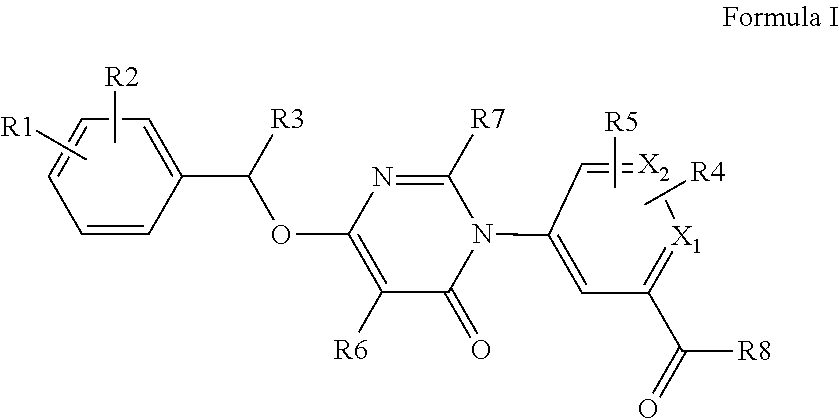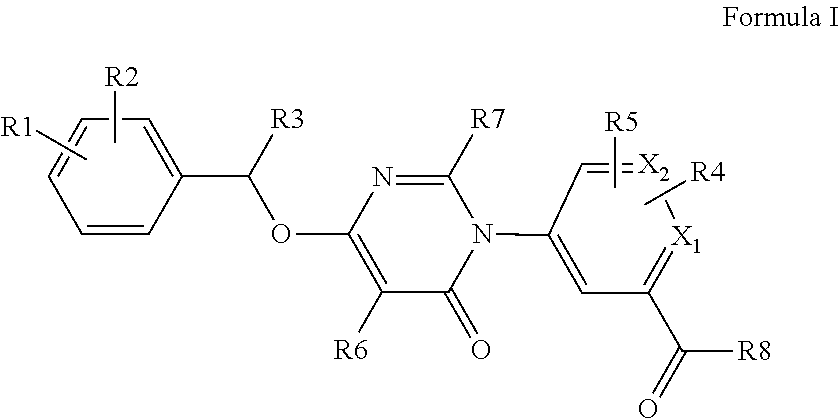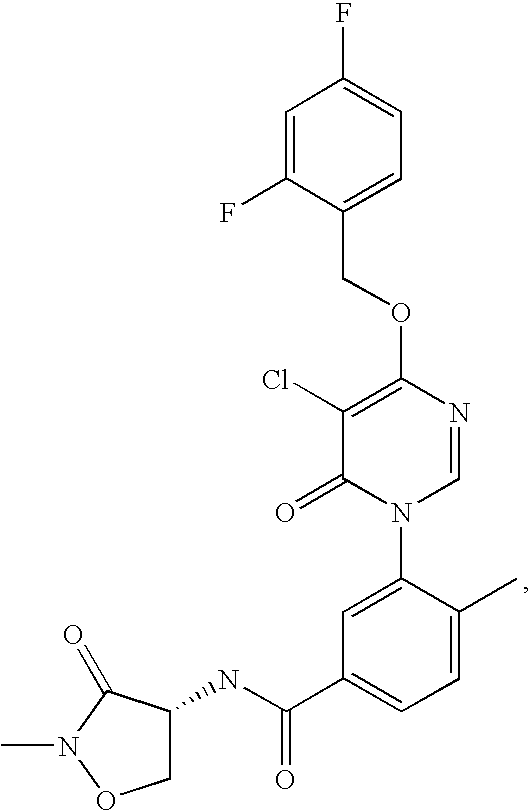Kinase inhibitor compounds
a kinase inhibitor and compound technology, applied in the field of pyrimidinone derivatives, can solve problems such as partial compromise, and achieve the effect of treating or lessening the severity of protein kinase modulation
- Summary
- Abstract
- Description
- Claims
- Application Information
AI Technical Summary
Benefits of technology
Problems solved by technology
Method used
Image
Examples
example 1
Preparation of 3-[5-Chloro-4-(2,4-difluoro-benzyloxy)-6-oxo -6H-pyrimidin-1-yl]-N-[(R)-2-(2-methoxy-ethyl)-3-oxo -isoxazolidin-4-yl]-4-methyl-benzamide
[0131]
[0132]Step 1: Compound la (202 mg, 1.0 mmol), 1b (167 mg, 1. 2 mmol), KI (174 mg, 1.05 mmol), K2CO3 (690 mg, 5.0 mmol) and acetonitrile (20 mL) were mixed in a microwave vial. The resulting mixture was reacted under microwave condition at 140° C. for 1 h. After being cooled, the mixture was filtered. The filtrate was evaporated and the residue was purified by column chromatography (EA: PE=1:3) to provide 1c (131 mg, 50.4%).
[0133]Step 2: To a solution of 1c (96 mg, 0.37 mmol) in DCM (3 mL) was added TFA (1 mL) drop-wise at room temperature. The mixture was stirred for 4 h and evaporated to provide crude 1d which was used for the next step directly.
[0134]Step 3: The solution of C (100 mg, 0.246 mmol), HATU (140 mg, 0.37 mmol) and DIEA (159 mg, 1.23mmol) in DMF (10 mL) was stirred at r.t. for 0.5 h. Compound 1d from last step in 2 ...
example 2
Preparation of 3-[5-Chloro-4-(2,4-difluoro-benzyloxy)-6-oxo-6H-pyrimidin-1-yl]-N-[(R)-2-(2-hydroxy-ethyl)-3-oxo-isoxazolidin-4-yl]-4-methyl-benzamide
[0135]
[0136]Step 1: The mixture of 1a (200 mg, 0.99 mmol), 2a (136 mg, 1. 09 mmol), KI (173 mg, 1.04 mmol) and K2CO3 (273 mg, 1.99 mmol) in DMF (5 mL) was stirred at r.t.
[0137]for 2 days, then heated to 60° C. for 3 h. After being cooled, the mixture was evaporated and the residue was purified by column chromatography (EA: MeOH=30:1) to provide 2b (60 mg, 24.7%).
[0138]Step 2: The following de-Boc and final coupling steps were similar to that of Example 1 to provide title compound (36 mg, 45.6% yield) as white solid. 1H NMR (CD3OD, 300 MHz): δ=8.31(d, 1H), 7.90-7.93(m, 1H), 7.79-7.80(m, 1H), 7.49-7.62(m, 2H), 6.97-7.04(m, 2H), 5.58-5.59(q, 2H), 5.13-5.16(m, 1H), 4.61-4.67 (t, 1H), 4.14-4.22(m, 1H), 3.67-3.75(m, 4H), 2.19(s, 3H). LC-MS: 533.0 (M−1)+. ; :
example 3
Preparation of 3-[5-Chloro-4-(2,4-difluoro-benzyloxy)-6-oxo-6H-pyrimidin-1-yl]-4-methyl-N-((R)-2-methyl-3-oxo-isoxazolidin-4-yl)-benzamide
[0139]
[0140]Step 1: The mixture of 1a (200 mg, 0.99 mmol), MeI (155 mg, 1. 09 mmol) and K2CO3 (205 mg, 1.49 mmol) in DMF (5 mL) was stirred at r.t. for for 3 h. After the reaction was complete, the mixture was evaporated and the residue was purified by column chromatography (EA: PE=1:5) to provide 3b (164 mg, 76.6%).
[0141]Step 2: The following de-Boc and final coupling steps were similar to that of Example 1 to provide title compound (87 mg, 70% yield) as white solid. 1H NMR (CD3OD, 300 MHz): δ=8.31(s, 1H), 7.78-7.94(m, 2H), 7.52-7.65(m, 2H), 7.98-7.06(m, 2H), 5.59-5.60(q, 2H), 5.08-5.11(t, 1H), 4.59-4.65 (t, 1H), 4.13-4.21(m, 1H), 3.19(s, 3H), 2.20(s, 3H). LC-MS: 505.1 (M+1)+.
PUM
| Property | Measurement | Unit |
|---|---|---|
| temperature | aaaaa | aaaaa |
| temperature | aaaaa | aaaaa |
| volume | aaaaa | aaaaa |
Abstract
Description
Claims
Application Information
 Login to View More
Login to View More - R&D
- Intellectual Property
- Life Sciences
- Materials
- Tech Scout
- Unparalleled Data Quality
- Higher Quality Content
- 60% Fewer Hallucinations
Browse by: Latest US Patents, China's latest patents, Technical Efficacy Thesaurus, Application Domain, Technology Topic, Popular Technical Reports.
© 2025 PatSnap. All rights reserved.Legal|Privacy policy|Modern Slavery Act Transparency Statement|Sitemap|About US| Contact US: help@patsnap.com



